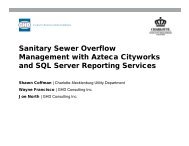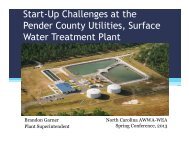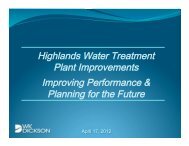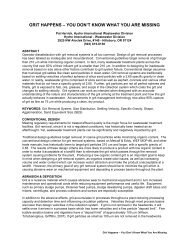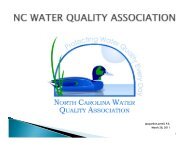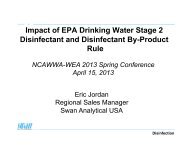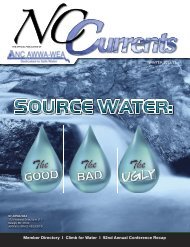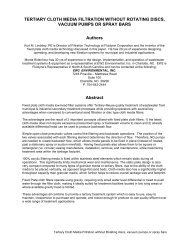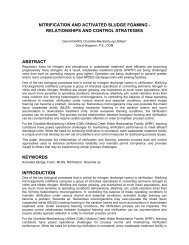HANDLING FATS, OILS & GREASES (FOG) AT WASTEWATER ...
HANDLING FATS, OILS & GREASES (FOG) AT WASTEWATER ...
HANDLING FATS, OILS & GREASES (FOG) AT WASTEWATER ...
Create successful ePaper yourself
Turn your PDF publications into a flip-book with our unique Google optimized e-Paper software.
sedimentation basins with the primary scum. A scum concentrator thickens the mixture where itcollected in a hopper and heated to approximately 130 o F. The <strong>FOG</strong> rich float is decanted andpumped to the midpoint of the dewatered solids conveyor for blending prior to entering theincinerator. The aqueous subnatant from the scum concentrator is recycled back to the head ofthe scum concentrator.Pinellas County, FLThe Pinellas County, FL South-Cross Bayou Water Reclamation Facility (SCBWRF) utilizesanaerobic digestion and sludge drying for solids disposal. <strong>FOG</strong> is accepted at an offsitereceiving facility where dewatering operations take place. Generally, the dewatering operationsare as follows:• The daily receipts are accumulated, mixed, and dosed at 1.5% polymer on a volumetric basis(15 gallons of polymer solution per 1,000 gallons of <strong>FOG</strong> waste).• The polymer-conditioned waste is stored overnight in a fine-screen dewatering tank, resultingin about 80% reduction in the weight of the <strong>FOG</strong> due to dewatering. The dewatered <strong>FOG</strong>concentration is typically about 20-30% solids.• The dewatered <strong>FOG</strong> is then transferred from the dewatering tank to a roll-on/roll-offcontainer for transfer to the WWTP.• The roll-on/roll-off container is equipped with a bottom drain and coupling such that whenthe container is received at the WWTP, the container is connected by hose to a rotary lobepump for transfer to a storage tank.Once at the facility, the <strong>FOG</strong> is injected into one of the egg-shape anaerobic digesters. Thebiogas produced from the facility currently used by the sludge pelletizer. Planned upgradesinclude heating the stored <strong>FOG</strong> and feeding it to new acid-phase reactors, along with receiving,storing and feeding lime-dewatered <strong>FOG</strong>. It is anticipated in the future, that that biogasproduction will exceed sludge drying fuel requirements wherein a new co-generation facility willbe constructed to produce energy.Essex Junction, VTThe Village of Essex Junction, Vermont operates a 3.3 mgd permitted wastewater treatmentfacility (EJWWTF) that is currently treating 2.0 mgd on an annual average daily basis. Thefacility provides service to 30,000 residents within the Towns of Essex and Williston, VT as wellas the Village. Waste primary sludge and GBT thickened WAS (TWAS) from the treatmentprocess is stabilized within mesophilic anaerobic digesters. In late 2003, the EJWWTF installeda combined heat and power (CHP) system utilizing two microturbines. The 30 kWmicroturbines utilized the digester gas of which nearly 50% was previously flared.Influent conditions at the facility indicated that <strong>FOG</strong> is an increasing problem. Without localresources for disposal of <strong>FOG</strong>, staff felt that it was not prudent to enforce existing ordinanceswithout providing a disposal solution. Through discussions of how to potentially handle the <strong>FOG</strong>as a separate waste, it was decided that direct addition of <strong>FOG</strong> to the anaerobic digesters wouldbe most beneficial as the facility had surplus hydraulic capacity in the digesters. As <strong>FOG</strong> is acarbon source and directly digestible, direct digestion was considered as it would increasemethane generation and power generation by the CHP system. In early 2005, the facility beganexperimenting with <strong>FOG</strong> addition and by the June was accepting <strong>FOG</strong> on a regular basis. This





